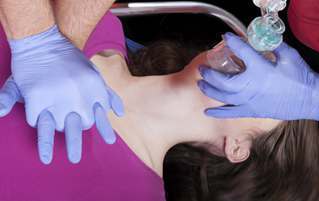6 Insane Realities Of Emergency Medicine (You Should Know)

We all grew up watching TV doctors use CPR to snatch teetering patients back from the edge of the mortal plane. But just how Hollywood-tainted is our concept of this ubiquitous life-saving technique? To find out, we spoke to "Josh." He's a bona fide doctor specializing in pulmonary and critical care medicine, and he told us that ...
No One Really Yells, "STAT!"

In the movies, hollering, "STAT!" is how you announce a life-threatening emergency. It signifies that any action should be done immediately, and also, it sounds super cool and dramatic when handsome men yell it into the face of quivering interns.
That never happens in reality.

Saying "stat," I mean. We still yell at the interns.
You might hear an overhead announcement to the effect of, "Adult stat, eight north. Adult stat, eight north." But it will be announced in the exact same tone of voice used to let you know a scrubs sale is happening in the gift shop. Should you actually follow a team to the room where shit's getting real, you'd be greeted by a weird quiet. Some amazing things will be happening, but they'll be happening without commentary. When I run a resuscitation effort, I know it's going well if no one but me is talking, and in these situations, I actually tend to speak more quietly and politely than usual. An ideal resuscitation effort would look calm to an outsider, like everyone had been rehearsing this for a very long time and knew exactly what to do.
Because they do, of course.

"I say, could you please pass me one-half milligram of epinephrine, old bean?"
"Pip-pip, right-o!"
"Brilliant!"
There's a protocol we follow when we're trying to save someone's life with ACLS, which stands for advanced cardiac life support. Knowing that protocol is how you get certified to do it. And the protocol includes precisely zero steps that involve shouting or running around with your arms flailing about like a panicked Muppet. It's all about control, clear communication between the team leader and the team members, and each member of the resuscitation team performing his or her duty. We've modeled how we do this on how airplane crews function.
Of course, that somber image I just painstakingly painted crumbles to bits as soon as I reveal what's really going on inside that doctor's head. See, CPR certification courses distribute a list of songs that provide the correct beat for performing chest compressions. Said playlist includes (perhaps appropriately) "Stayin' Alive" and (perhaps less appropriately) "SexyBack."
That one's under FDA review due to the tendency of hospital staff to forget what they're doing
and start grinding on each other.
Yes. Somewhere, right now, there's a doctor humming "SexyBack" as he chest-pumps a lolling patient. Don't give him shit for it; bringing sexy back is medically necessary.
Defibrillators Are Not Used Very Often

You want to save somebody in a movie, you have to zap them like a human Hot Pocket. You rub the paddles together, you shout, "CLEAR!" -- because you're about to send a Frankensteinian amount of juice through the body -- and then you electrocute that dying son of a bitch until he agrees to live again.

"By the power of Grayskull! CLEAR!"
In reality, we rarely shock people, because only specific malignant heart rhythms respond to a shock. If you're lucky enough to have one of those and have it recognized really quickly, then you're a candidate for electrical therapy. But you're also more likely to do better with CPR, overall.
So why all the defibrillators? Simple. On the off chance that you do have a "shockable rhythm" when you go down, it's super important for a nearby do-gooder to shock the shit out of you as quickly as possible. For each minute they delay, your predicted chance of survival goes down by about 10 percent. To save you the trouble of breaking out your calculator, that's 10 minutes to dead -- which, incidentally, is also the name of the band I'm going to start if this whole doctor thing doesn't work out.

All the heartbeat-rhythm stuff has given me ridiculous bassline ideas.
Real CPR Is A Brutal Procedure

In TV CPR, George Clooney gently pumps the patient's chest while a constant stream of flirty chit-chat flits back and forth between him and his sexual conquest of the week. If it's going poorly, maybe he'll give it a "You're not dying on me today!" and one solid, dramatic blow to the chest. In reality, you won't be flirting while performing chest compressions, because they're a serious workout. You're trying to compress the chest about two inches at a rate of at least 100 times per minute. You're squeezing the heart hard enough to move blood all throughout the body, and the heart lives inside a basket made of bone. So bones will likely break. This is normal, but it sure makes flirting awkward, in between the snap-crackle-pop of a human ribcage shattering.

"Say, do you want to split a full-slab at that new barbecue place for lunch?"
We're also going to shove a plastic tube about the diameter of a thumb down your throat and into your windpipe, after we use a curved piece of steel to drag annoyances like your tongue out of the way. We'll probably jam a large plastic tube into the big vein in your groin, or maybe the one in your neck or under your collarbone, depending on where we can get to at the time. And we might even cut a hole in the side of your chest and shove another plastic tube between your lung and your chest wall, or maybe stick a needle into the sac around your heart.
It'll save your life, of course, but sometimes it feels like a pretty fucked-up thing to do to a person.
Post-CPR Care Is Straight Out Of Science Fiction
After TV CPR, the patient immediately wakes up and breathlessly thanks the doctor for saving their life. I can count on one finger the number of times I've seen it go down that way in reality. If you get a pulse back, the patient doesn't wake up, but that is when the really cool stuff starts.
Especially if Flatliners is accurate.
If you have return of spontaneous circulation, meaning your heart is doing its job, but you're still comatose and you're not bleeding like a stuck hog, we put you in the ICU and drop your body temperature to somewhere around 90 degrees F for up to an entire day. We have to give you a special drug to temporarily paralyze you in order to prevent shivering (which, at that temperature and for that duration, would cause serious muscle damage). You're so cold that your heart rate drops, your blood chemistry gets all wacky, and blood clotting doesn't work. You're basically as close as we can get to the cryo-sleep from Aliens.
CPR Is Way Less Effective Than You Think

On TV, three-quarters of the characters that undergo CPR survive, and most leave the hospital with something that looks like a normal life ahead of them. Let's set the record straight: As of about five years ago, if you dropped dead from a cardiac cause while outside the hospital, CPR gives you less than a 10 percent chance of making it out of the hospital alive.
Which is why, if at all possible, you should try to have your heart attack on a TV show and/or movie.
But that's dropping dead on a street corner. If something catastrophic happens to your heart while you're in the hospital, you've got about a 25 percent shot of living through it. Much better than 1 in 10, but it's hardly as though modern medicine has a lock on resuscitation yet. Most folks still die only once.

"Goddammit, I only have nickels!"
As for those lucky few who do leave the hospital outside of a bag, only about half of them end up with what is described as a "favorable functional status." This basically means you can walk on your own and aren't pissing and shitting on yourself, but you still need help on a continual basis. So, in this instance, "favorable" is strictly defined as "hey, marginally better than dead."
CPR Isn't For Everybody

Though adults overall have about a 25 percent chance of leaving the hospital alive after temporarily croaking, if you're over the age of 70, your odds drop to somewhere between 11 percent and 18 percent. And the older you are, the worse they get. A fairly large portion of those survivors will have major physical and cognitive disabilities, much like what you'd see if you bashed them in the head with a baseball bat instead of saving their life with a medical procedure.

"A bat to the head is actually why he's in here. Always pay your bookie."
Make no mistake: CPR does improve odds of survival. If you know what you're doing and you see someone drop on the street, by all means, scream, "STAT!" (not because it means anything but because when else will you get the chance?) and start hands-only CPR. But we often behave as though everything that ails us is fixable, up to and including death. If someone has the balls to tell us that maybe we shouldn't do painful things to sick, old people that are extremely unlikely to accomplish anything other than prolong pain, suffering, and disability, we start tossing around words like "death panels."

And then you've got Sandmen chasing Runners, and before you know it,
Charlton Heston is eating everybody.
I'll leave you with this: A very experienced and very respected colleague of mine, who has attempted resuscitation on thousands of patients, says, "If you find me down in the hallway, walk away and come back in 30 minutes. Whatever's gonna happen will have happened by then." He's only kidding a little bit.
Jason is an editor for Cracked. Life is short; like his Facebook page.
It's time to blow the doors off this whole Hollywood bullshit. Check out 5 Things I Learned As A Cop (That Movies Won't Show You) and learn about all the male nudity that goes on. Or read 5 Reasons Doing Movie Stunts Is Harder Than You Think and learn why doing movie stunts isn't for adrenaline junkies.
Subscribe to our YouTube channel to see how Hollywood also does firearms wrong in 5 Gun Myths You Probably Believe (Thanks to Movies), and watch other videos you won't see on the site!
Also follow us on Facebook, because we'd love to give you mouth-to-mouth.
Have a story to share with Cracked? Email us here.

